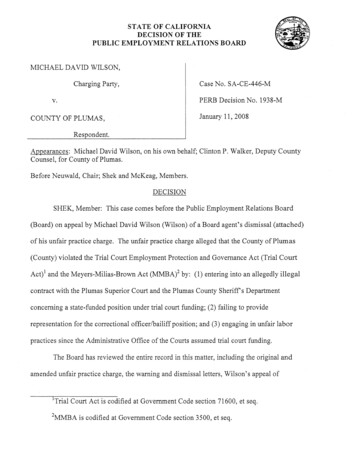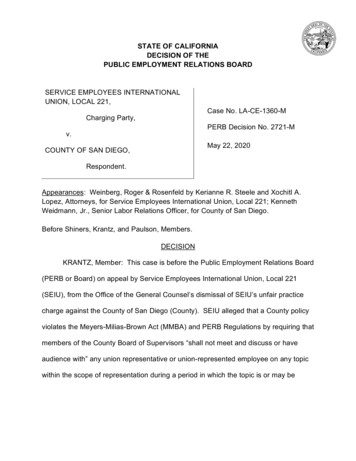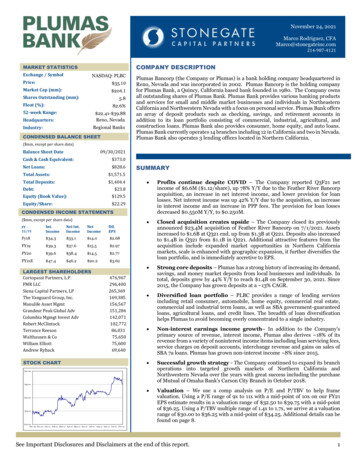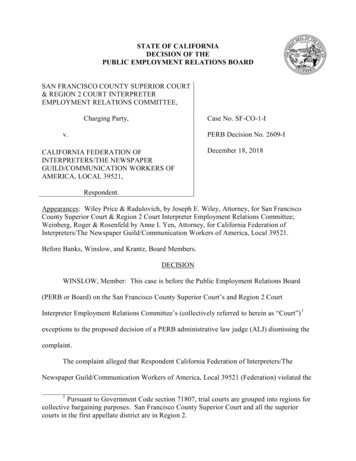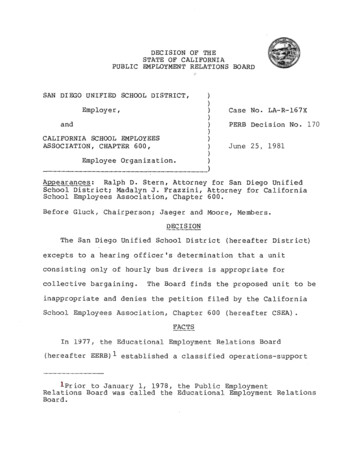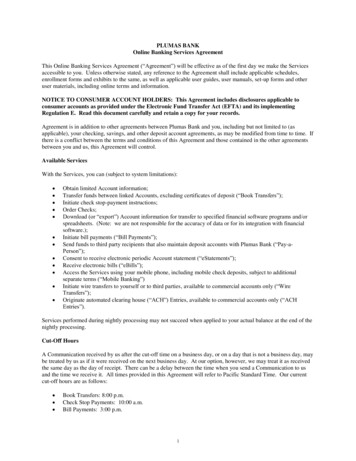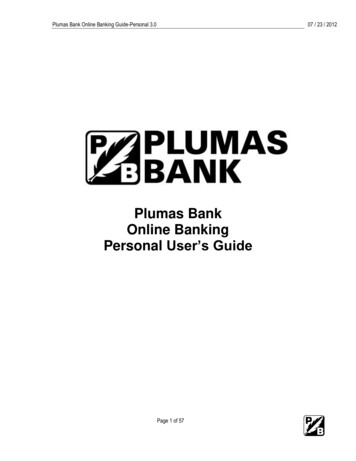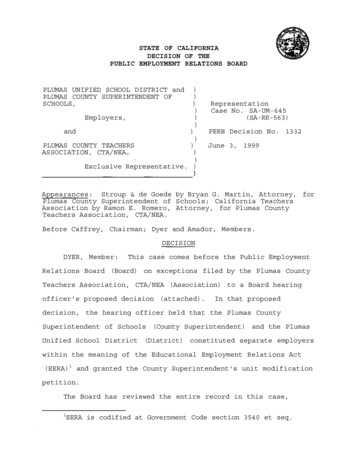
Transcription
STATE OF CALIFORNIADECISION OF THEPUBLIC EMPLOYMENT RELATIONS BOARDPLUMAS UNIFIED SCHOOL DISTRICT andPLUMAS COUNTY SUPERINTENDENT OFSCHOOLS,)))))Employers,))and))PLUMAS COUNTY TEACHERS)ASSOCIATION, CTA/NEA,)Exclusive Representative. )RepresentationCase No. SA-UM-645(SA-RR-563)PERB Decision No. 1332June 3, 1999Appearances: Stroup & de Goede by Bryan G. Martin, Attorney, forPlumas County Superintendent of Schools; California TeachersAssociation by Ramon E. Romero, Attorney, for Plumas CountyTeachers Association, CTA/NEA.Before Caffrey, Chairman; Dyer and Amador, Members.DECISIONDYER, Member:This case comes before the Public EmploymentRelations Board (Board) on exceptions filed by the Plumas CountyTeachers Association, CTA/NEA (Association) to a Board hearingofficer's proposed decision (attached).In that proposeddecision, the hearing officer held that the Plumas CountySuperintendent of Schools (County Superintendent) and the PlumasUnified School District (District) constituted separate employerswithin the meaning of the Educational Employment Relations Act(EERA)1 and granted the County Superintendent's unit modificationpetition.The Board has reviewed the entire record in this case,1EERA is codified at Government Code section 3540 et seq.
including the hearing transcript, the proposed decision, theAssociation's exceptions, and the County Superintendent'sresponse thereto.The Board finds the hearing officer's findingsof fact and conclusions of law to be free from prejudicial errorand adopts them as the decision of the Board itself.2ORDERUpon the findings of fact, conclusions of law, and theentire record in the case, it is hereby ORDERED that anappropriate unit shall include only those certificated employeeswho are employed by the Plumas County Superintendent of Schools.Accordingly, the certificated bargaining unit of the PlumasUnified School District shall include only those persons employedin certificated positions by the District.Chairman Caffrey and Member Amador joined in this Decision.2In so doing, we hold that EERA section 3540.1(k) does notpreclude the possibility of two entities acting as a single or ajoint employer within the meaning of the EERA.(See UnitedPublic Employees v. Public Employment Relations Bd. (1989)213 Cal.App.3d 1119 [262 Cal.Rptr. 158] [holding that city andschool district acted as joint employer under EERA].) In thiscase, however, the hearing officer properly found that theDistrict and the County Superintendent were separate employers.2
ISTATE OF CALIFORNIAPUBLIC EMPLOYMENT RELATIONS BOARDPLUMAS UNIFIED SCHOOL DISTRICT and ))PLUMAS COUNTY SUPERINTENDENT OF)SCHOOLS,))))))))Employers,andPLUMAS COUNTY TEACHERSASSOCIATION, CTA/NEA,RepresentationCase No. SA-UM-645(SA-RR-563)PROPOSED DECISION(1/14/99)Exclusive Representative.)Appearances: Stroup & de Goede by Bryan G. Martin, Attorney, forPlumas County Superintendent of Schools; Ramon E. Romero,Attorney, for Plumas County Teachers Association, CTA/NEA.Before Les Chisholm, Hearing Officer.PROCEDURAL HISTORYA bargaining unit established through voluntary agreementincludes certificated employees of both the Plumas Unified SchoolDistrict (District) and the Plumas County Superintendent ofSchools (County Superintendent), and is represented by the PlumasCounty Teachers Association, CTA/NEA (Association).OnNovember 24, 1997, the County Superintendent filed the instantunit modification petition with the Public Employment RelationsBoard (PERB or Board).The petition seeks to modify the unit inorder to have those certificated employees employed by the CountySuperintendent, most of whom are Regional Occupational Program(ROP) teachers, included in a unit separate and apart from a unitincluding District employees.The petition was filed pursuant to
PERB Regulation 32781 (b) (1). 1 By letter dated December 10,1997, the Association opposed the petition.A settlement conference was held with the parties onJanuary 30, 1998, and a formal hearing was conducted onAugust 18, 1998.Upon the receipt of both parties' briefs onOctober 5, 1998, the case was submitted for decision.2FINDINGS OF FACTGovernance and StructureThere is only one school district in Plumas County.3TheCounty Superintendent has been established as a separate electedoffice for at least as long as the District has been inexistence.The current County Superintendent, William J.1PERB regulations are found at California Code ofRegulations, title 8, section 31001 et seq. Section 32781(b)(1)provides:(b) A recognized or certified employeeorganization, an employer, or both jointlymay file with the regional office a petitionfor unit modification:(1) To delete classifications orpositions no longer in existence orwhich by virtue of change incircumstances are no longer appropriateto the established unit[.]2While neither party formally sought to reopen the record,the Association wrote on October 20, 1998, concerning allegedfactual errors and omissions in the County Superintendent'sbrief, and the County Superintendent responded to that letter onOctober 26, 1998. The undersigned has relied upon the hearingrecord and PERB case files, not the parties' briefs, insummarizing the facts of this case and finds it unnecessary toaddress the factual accuracy of either party's brief.3However, the Sierra-Plumas Joint Unified School District,which is located in and includes all of Sierra County, alsoincludes a small portion of Plumas County within its boundaries.22
Cottini, was elected in 1990.Historically, the offices ofCounty Superintendent and District superintendent were held bythe same individual.However, when Cottini assumed office inJanuary 1991, the District Governing Board did not name him asthe District superintendent.The elected members of the District's Governing Boardautomatically serve as members of the Board of Education (CountyBoard) of the Plumas County Office of Education (COE).4TheCounty Board and Governing Board normally meet on the same day,but the two boards convene separately, each with its own distinctagenda.The County Superintendent's powers include hiring anddiscipline of COE staff; the County Board has no authority overhiring or discipline.5The County Board approves the COE budgetand the County Superintendent's salary.The offices of the County Superintendent are housed in theDistrict's headquarters office in Quincy.In addition to theinstructional programs of the COE, the County Superintendent isresponsible for reviewing and submitting to the state theattendance reports of the District, and prepares reports to theState Teachers Retirement System and Public Employees RetirementSystem for the COE, the District and the Feather River CommunityCollege District (Community College).4See Education Code section 1000.5Employer Exhibits 1 and 2; Education Code sections 12401271, 1290-1295 and 1040-1110.33
The County Superintendent also administers data processing,business, media center and print shop services.The Districtutilizes the COE's media center and print shop and pays for useof these services.The County Superintendent processes warrantsand payroll for both the District and Community College.TheDistrict and Community College each pay the COE for theseservices.The County Superintendent likewise reimburses the Districtfor personnel services provided by the District's personneldirector.The District's personnel office handles theadvertising for open positions, helps establish the screening andinterview panels,6 schedules interviews, processes paperwork andsuch requirements as finger printing for successful candidates,and issues formal employment offers on behalf of the CountySuperintendent.However, the District personnel director is notinvolved in grievance administration or discipline issuesinvolving COE staff.BargainingThe County Superintendent, not the County Board, has theauthority to approve collective bargaining agreements, while theGoverning Board must ratify any agreement on behalf of theDistrict.The collective bargaining agreement (Agreement) forthe certificated unit is trilateral, identifying the Association,the Governing Board and the County Superintendent as parties.6The personnel director consults with Cottini on thecomposition of panels. Screening panels involve only COEpersonnel, but interview panels also often include Districtemployees.44
However, the Agreement refers to the Governing Board and CountySuperintendent collectively therein as "Board."The signatoriesto the agreement are the Association, the Districtsuperintendent, the District's board president and the CountySuperintendent.7The County Superintendent has had a representative on theDistrict's bargaining team with the Association at least as longas Cottini has held office.Cottini participated initially andis now represented by Larry Champion, Assistant Superintendent/ROP Director.The County Superintendent also negotiates with COEclassified staff, who are represented by the California SchoolEmployees Association (CSEA).The County Superintendent grantedvoluntary recognition to CSEA in July 1993 (PERB Case No.SA-RR-945).Previously, the classified staff of the District andCounty Superintendent were included in a single bargaining unit.The Established Certificated UnitThe most recent Agreement describes the recognizedbargaining unit as includingall certificated employees holding thefollowing job classifications: elementary andsecondary teachers; librarians; speechtherapists; music specialists; elementary andsecondary special education teachers; nurses;continuation education teachers; counselors;7The reference to the Governing Board and CountySuperintendent collectively as employer in collective bargainingagreements has been followed since at least 1981. However, inthe agreement for July 1, 1981 through June 30, 1987, there wereonly two signatories: One for the Association and one signingfor both employers.55
school psychologists; and R.O.P. instructors,half-time or more . t8]The certificated bargaining unit presently includes more than 200District employees and approximately 22 COE employees.The existing unit was first established when, by letterdated May 7, 1976, the District and County Superintendentnotified PERB of the voluntary recognition of the Association fora unit of all certificated employees, excluding the Districtmanagement team, full-time vice principals, ROP instructors,substitutes, and county schools.9The ROP teachers were lateradded to the unit through a joint unit modification petitionwhich, inter alia, sought the addition of ROP instructors.10PERB approved that petition on December 8, 1980.COE BudgetROP funding is based on average daily attendance (ADA).TheCOE also receives ADA-based funding for a court/community school,and additional monies from forest reserves and from the countysuperintendent service fund.Other programs and operations of8An individual employee is considered included in the unitwhen his or her cumulative appointment(s) with the Districtand/or County Superintendent equals half-time (.50) or more.Correspondence related to that petition (PERB Case No.SA-RR-563) and the subsequent recognition sometimes referred onlyto the District as employer but more often made reference to theDistrict and County Superintendent collectively as the employer.10While the County Superintendent was not separately listedas a petitioning party, the petition (PERB Case No. SA-UM-105)did include references to the District and County Superintendentcollectively as employer. At that time, the positions ofDistrict superintendent and County Superintendent were held bythe same person.6
the COE are funded based on grants or from billings for servicessuch as data processing.The funding of the COE is distinguished from the District inseveral ways.The ADA for ROP is based on hour by hourattendance records (actual "seat time"), while K-12 attendance isonly taken once per school day.The District receives additionalfunding from sources such as mentor teacher, school improvement(SIP), and incentive grants.Some years the ROP is treated as acategorical program and thus does not receive a cost of livingadjustment, even in years that the District does.The ROP isrestricted in terms of the amount of reserves it may carry.COE ProgramsThe ROP was established in the early 1970's as a COE programand was initially created as a three-county program includingPlumas, Sierra and Lassen.11Lassen County later formed its ownprogram, but the COE still provides the ROP for Plumas and Sierracounties, with the bulk of the attendance being in Plumas.Nurses training programs of the ROP are offered in Plumas,1Education Code section 52301 provides in part that thecounty superintendent of schools of eachcounty, with the consent of the State Boardof Education, may establish and maintain, orwith one or more counties may establish andmaintain, at least one regional occupationalcenter, or regional occupational program, inthe county to provide education and trainingin vocational courses. The governing boardsof any school districts maintaining highschools in the county may, with the consentof the State Board of Education and of thecounty superintendent of schools, cooperatein the establishment and maintenance of aregional occupational center or program[.]77
Sierra, Shasta and Nevada12 counties; school to work programs inPlumas, Modoc and Lassen counties; and various grant-fundedprograms, such as Computers in Our Future and AmeriCoach, inPlumas County.In addition to nursing programs, the ROP offers instructionin computer applications, administration of justice, computerassisted drawing, forestry, TV production, computer accounting,mechanical drawing, welding, bus driver training, andconstruction, automotive, food service, restaurant, agriculture,computer, medical and business occupations.Approximately 20 percent of the ROP students, including allin the nursing programs, are adult learners, and the balance areregular high school students (16 or older).Most regularstudents served by the ROP program attend a class at their schoolsite.Most ROP instruction, in fact, takes place in classroomslocated at high schools and continuation schools of the Districtor the Sierra-Plumas Joint Unified School District.The majorexceptions involve the nursing programs (classroom andclinical/hospital settings), construction occupations (job sitesand classroom) and bus driver training (maintenance yard).COE WorkforceInitially, the ROP hired all of its own teachers.However,in the early 1980's, the District laid off teachers and cut manyvocational programs.The ROP picked up some of the laid off12References to a certified nursing aid program in Truckeesometimes placed it in El Dorado County and other times in NevadaCounty. Truckee is located in Nevada County.88
teachers and the County Superintendent and District began apractice of sharing individual teacher contracts.Presently, several different employment arrangements areutilized for persons delivering instruction for the CountySuperintendent.13For example, the ROP has two instructorslocated at Loyalton High School in Sierra County.One is a full-time employee of the Sierra-Plumas Joint Unified School District.The County Superintendent contracts with that district to pay forhalf of the salary and other costs.The other is a full-timeemployee of the County Superintendent, and the Sierra-PlumasJoint Unified School District pays half of that cost.Many more such arrangements are found between the Districtand County Superintendent.While the status quo is fluid,approximately 11 bargaining unit members teach for both theDistrict and County Superintendent.Where an employee holdsmultiple positions with both the District and COE, the employeereceives a payroll warrant from each but is issued only oneemployment contract.The County Superintendent's agreement iswith the District in that case, not with the employee.Describing this type of arrangement, Larry Champion testified:At present we contract with the District fora portion of that time, but we do notcontract with the individual.13The COE projected filling the full-time equivalent (FTE)of 18.12 positions for 1998-1999, involving up to 42 separateappointments.99
The County Superintendent directly employs approximately 11certificated employees who are not also employed by theDistrict.14The credentialing requirements for ROP teachers differ fromthose of most classroom teachers by emphasizing work experienceover academic achievement.However, many ROP teachers have beenor are regular classroom teachers and many, if not most, meetboth types of credential requirements.Terms and Conditions of EmploymentUnder the Agreement, the type of credential held does notaffect placement on the salary schedule.In fact, the rights andbenefits of unit members generally apply equally to employees ofboth the District and COE.15The Agreement specifies that COEand District employees can mutually donate sick leave hours forcatastrophic leave benefits.The Agreement further provides fora common seniority pool for COE and District employees, based onthe employee's first date of paid service in a probationarystatus with either employer.There was unrebutted hearingtestimony that ROP teachers cannot achieve tenure or permanentstatus as ROP teachers and, thus, the process involved in anydisciplinary issue would be different for them.However, thesedistinctions are not reflected in the Agreement.14The numbers addressed in this paragraph concern only thosepersons in positions included in the certificated bargaining unitand not those working less than half-time.15The Agreement, at Section 2.03, states that references to"unit member" include all represented employees unless specifiedotherwise.10
As noted previously, certain ROP teachers work in nonclassroom settings and their hours, particularly for those innursing programs, are quite different than those of classroomteachers.Both the District and County Superintendent employindividuals in itinerant teaching positions.Whether employed solely by the County Superintendent or bythe District as well, the majority of ROP teachers are located atDistrict schools and are well integrated into the workenvironment.For example, Wes Stoddard has been continuouslyemployed both as an ROP teacher and a "regular" teacher at QuincyHigh School since 1983.He currently teaches metal and wood shopfor the District and welding for the ROP, and uses the sameclassroom for all courses.Stoddard and other ROP teachers atQuincy, including two who are full-time employees of the CountySuperintendent, attend faculty meetings at their school and inthe District; use the same faculty lounge and parking lot asother teachers; are supervised and evaluated by the same siteadministrator; and perform extra duty assignments such as classadvisor, coaching, and bus and dance duty.Stipends are paid forextra duty assignments, just as the County Superintendent paysextra duty stipends to certain District teachers who performduties under its AmeriCoach grant.This seamless integration of ROP and regular teachers hasbeen accomplished by design.Larry Champion described the planas follows:We have an agreement with the sites, and itis one that has evolved, our intent is thatthe ROP teacher be an inclusive part of every11
staff, that the part that they serve isseamless, that no one knows the difference,they're a teacher on the site and that is agood thing.Nevertheless, the County Superintendent has not cededcontrol over his programs to the District.While the siteadministrator evaluates ROP teachers, Champion would be involvedif there were problems identified by the evaluation and Cottinimust approve any adverse action or discipline.Also, in additionto attending site staff meetings, ROP teachers attend ROP staffmeetings, including ones held in conjunction with District-widemeetings.Champion meets with ROP teachers individually on aregular basis as well.Finally, ROP teachers initiate contactsto make requests for money and supplies for programs with boththeir site administrators and Champion.POSITIONS OF THE PARTIESDistrictThe District did not appear at the hearing, nor state aposition on the County Superintendent's petition at any time.County SuperintendentThe County Superintendent's argument is organized into threeparts:The separate and distinct status of the CountySuperintendent as a public school employer, the adverse impactthat the established bargaining unit has on COE operations, andcommunity of interest considerations.Concerning status as a separate employer, the CountySuperintendent cites Education Code sections 1240 et seq., whichauthorize the county superintendent of schools to conduct12
operations as a distinct employer, including the hiring anddiscipline of both classified and certificated staff.The CountySuperintendent also cites 72 Ops.Cal.Atty.Gen. 25 and AlamedaCounty Board of Education and County Superintendent of Schools ofAlameda County (1983) PERB Decision No. 323 (Alameda) .16The County Superintendent further argues that separateemployer status is evidenced by the fact that the CountySuperintendent has fewer and different funding sources than theDistrict.In addition, the County Superintendent operates undera limitation not applicable to the District since the law allowsno more than a 15 percent ROP reserve and requires that any fundsin a ROP reserve be used only for capital outlay.The final point regarding separate employer status is thatthe County Superintendent has authority to approve, or withholdapproval from, a collective bargaining agreement.This authorityis exercised on an equal basis with the District's GoverningBoard.The second argument made by the County Superintendentconcerns the adverse impact of the current unit configuration onthe COE, as evidenced by the effect of a retroactive salarypayment negotiated in a prior year.Night school programs of theCounty Superintendent had to be reduced, as well as expendituresfor supplies and equipment, in order to meet the requirements ofthe salary increase.The ability of the County Superintendent to16Both the Attorney General's Opinion and Alameda addressedthe relative authority of the county superintendent and a countyboard of education over employer-employee relations issues.13
plan and administer programs would be enhanced if the CountySuperintendent had autonomy to bargain based on the revenuestream and budget of his office.Finally, since the County Superintendent is a separate anddistinct employer, traditional community of interests factorshave limited application in this case.However, viewed in theirtotality as required by Monterey Peninsula Community CollegeDistrict (1978) PERB Decision No. 76, these factors also supportapproval of the requested unit modification.The geographicalarea in which County Superintendent employees work is far broaderthan Plumas County; the working sites and conditions for manyemployees, especially those in nursing programs, are quitedifferent than those of regular classroom teachers; theirtraining and backgrounds are different than District teachers;and the educational mission is directed toward vocational skillsrather than fundamental academic skills.AssociationThe Association argues that the parties' stable bargainingrelationship (Los Angeles Unified School District (1998) PERBDecision No. 1267) and the community of interest shared by theDistrict's and County Superintendent's certificated staff requirefinding the existing unit appropriate.The Association relies onstatutory criteria (EERA section 3545(a))17 and PERB precedent.(Kings County Office of Education (1990) PERB Decision No. 801.)"The Educational Employment Relations Act (EERA) iscodified at Government Code section 3540 et seq.14
The Association contends that the teachers at issue are onthe same salary schedule, receive the same benefits, share commonsupervision, have frequent interaction, and often work on similarextra duty assignments such as coaching or serving as classadvisor.The teachers also share many goals, as educators and asemployees, and belong to the same employee organization.Further, the credentialing differences between ROP andregular teachers are not significant and any difference isrendered moot under Stanislaus County Office of Education (1993)PERB Decision No. 1022 (Stanislaus).In Stanislaus, the Boardapproved the addition of a certificated naturalist position tothe teachers unit despite differences in working conditions,funding source and other community of interest indicia.The second prong of the Association's argument relies onNational Labor Relations Board (NLRB) precedent for the conceptof a "single employer" relationship between the District andCounty Superintendent.Under federal precedent, according to theAssociation, two or more ostensibly separate entities may befound to constitute a "single employer" for bargaining andrepresentation purposes based on consideration of four factors:(1) Functional integration of operations; (2) centralized controlof labor relations; (3) common management; and (4) commonownership or financial control.If the "single employer"analysis is not found persuasive, the Association offers a "jointemployer" theory in the alternative.1818A "joint employer"The Association also suggests, alternatively, use of a"dual" employer concept, but does not further define it. The15
relationship can be found in the absence of common ownershipwhere two employers share in the control of labor relations andworking conditions of employees.(W.W. Grainger, Inc. v. NLRB(1988) 860 F.2d 244 [129 LRRM 2718].)The bottom line for theAssociation is that many COE employees are also employed by theDistrict and are, in both capacities, supervised by Districtadministrators.Finally, the Association, relyingon State of California(Department of Personnel Administration) (1990) PERB Decision No.794-S (State of California), argues that the CountySuperintendent has failed to carry the requisite burden ofdemonstrating the proposed unit modification is more appropriatethan the existing unit configuration.ISSUEShould the existing certificated bargaining unit be modifiedto remove those employees employed by the County Superintendent?If so, should those employees be placed in a separate unit withcontinued representation by the Association?DISCUSSIONJurisdictionBoth the District and the County Superintendent are publicschool employers within the meaning of the EERA, the Associationis a recognized employee organization within the meaning of theBoard, in San Francisco Community College District (1986) PERBOrder No. Ad-153, rejected adding a third concept to the "singleor joint" employer equation.16
EERA, and the employees who are the subject of this petition areemployees within the meaning of the EERA.Single v. Joint EmployerBoth the Board19 and federal courts20 have observed thatthe distinct concepts of "single employer" and "joint employer"are often used incorrectly as interchangeable terms.InBrowning-Ferris, the court held:[A]s the Supreme Court itself has recognized,the two concepts approach the issue of "whois the employer," from two differentviewpoints. As such, different standards arerequired for each[.]The Browning-Ferris court, citing Radio and Television BroadcastTechnicians Local Union 1264 v. Broadcast Service of Mobile, Inc.(1965) 380 U.S. 255 [58 LRRM 2545] (Broadcast Service). definedthe "single employer" concept as follows:A "single employer" relationship exists wheretwo nominally separate entities are actuallypart of a single integrated enterprise sothat, for all purposes, there is in fact onlya "single employer." The question in the"single employer" situation, then, is whetherthe two nominally independent enterprises, inreality, constitute only one integratedenterprise.[Italics in original.]The Browning-Ferris court also noted that, under BroadcastService, four factors are examined to answer whether a "singleemployer" relationship is present under the particular facts of acase:(1) Functional integration of operations; (2) centralized"Turlock School Districts (1977) EERB Order No. Ad-18(Turlock). (Prior to January 1, 1978, PERB was known as theEducational Employment Relations Board (EERB).)20NLRB v. Browning-Ferris Industries of Pennsylvania, Inc(CA 3, 1982) 691 F.2d 1117 [111 LRRM 2748] (Browning-Ferris).17
control of labor relations; (3) common management; and (4) commonownership or financial control.Citing NLRB v. Greyhound Corp. (1964) 376 U.S. 473 [55 LRRM2694] as the lead case, the Browning-Ferris court held that the"joint employer" conceptdoes not depend upon the existence of asingle integrated enterprise and thereforethe above-mentioned four factor standard isinapposite. Rather, a finding that companiesare "joint employers" assumes in the firstinstance that companies are "what they appearto be" -- independent legal entities thathave merely "historically chosen to handlejointly . . . important aspects of theiremployer-employee relationship." NLRB v.Checker Cab Co. 367 F.2d 692, 698, 63 LRRM2243 (6th Cir. 1966).In "joint employer" situations no finding ofa lack of arm's length transaction or unityof control or ownership is required, . . ."[i]t is rather a matter of determining whichof two, or whether both, [employers] control,in the capacity of employer, the laborrelations of a given group of workers." NLRBv. Condenser Corp. of America [128 F.2d 67]. . . Thus, the "joint employer" conceptrecognizes that the business entitiesinvolved are in fact separate but that theyshare or co-determine those matters governingthe essential terms and conditions ofemployment. [Citations omitted; italics inoriginal.]PERB PrecedentThe Board has twice directly addressed the question ofwhether two school districts could be considered, for purposes ofcollective negotiations and representation, a "single employer."In Turlock, the essential facts before the Board were asfollows.The Turlock Joint Union High School D
PLUMAS COUNTY TEACHERS ASSOCIATION, CTA/NEA, Exclusive Representative. Representation Case No. SA-UM-645 (SA-RR-563) PROPOSED DECISION (1/14/99) ) Appearances: Stroup & de Goede by Bryan G. Martin, Attorney, for Plumas County Superintendent of Schools; Ramon E. Romero, Attorney, for Plumas County Teachers Association, CTA/NEA.
